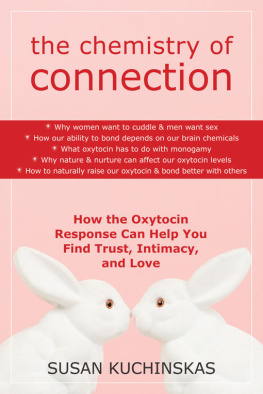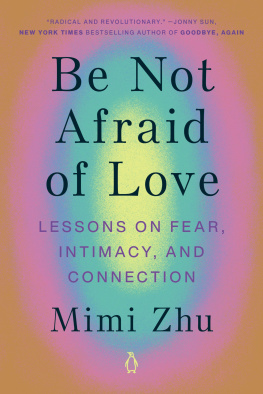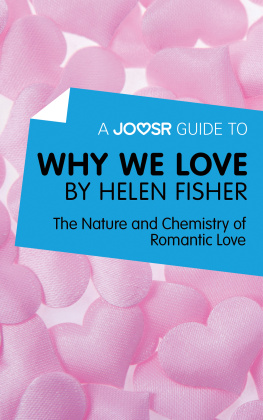This book is full of fascinating information about the biology of attachment. It uses the newest data from psychology, neuroscience, and molecular biology to explain how we love, why we sometimes cant, and how to develop this deep human capacity by understanding oxytocin. I learned a lot about myself and the people I love.
Helen Fisher, professor at Rutgers University and author of Why We Love and Why Him? Why Her?
The Chemistry of Connection is a beautiful book about how to nurture lasting love between ourselves, our mates, and our children. Kuchinskas gives readers essential information about connection and bonding. She helps readers understand the brain chemistry behind who we are.
Michael Gurian, author of The Wonder of Girls and What Could He Be Thinking?
The Chemistry of Connection is a marvelous book. It brings the science of oxytocin into the service of love in an engaging and practical way. Anyone who wants to understand and improve his or her relationships should read it.
Paul J. Zak, Ph.D., professor and director of the Center for Neuroeconomic Studies at Claremont Graduate University, discoverer of the relationship between oxytocin and trust
We know intuitively that hugging and cuddling are not just good for you, but essential ingredients to well-being. This book explains why. Read it to learn how to get more nurturing connection in your life.
Reid Mihalko and Marcia Baczynski, creators of Cuddle Party
In The Chemistry of Connection, Susan Kuchinskas helps her readers understand important aspects of how oxytocin enhances relationships, and more importantly, how to navigate some of the obstacles we encounter on the often rocky road to love.
Barton Goldsmith, Ph.D., author of Emotional Fitness for Couples and Emotional Fitness for Intimacy

Publishers Note
This publication is designed to provide accurate and authoritative information in regard to the subject matter covered. It is sold with the understanding that the publisher is not engaged in rendering psychological, financial, legal, or other professional services. If expert assistance or counseling is needed, the services of a competent professional should be sought.
Distributed in Canada by Raincoast Books
Copyright 2009 by Susan Kuchinskas
New Harbinger Publications, Inc.
5674 Shattuck Avenue
Oakland, CA 94609
www.newharbinger.com
Cover design by Amy Shoup; Text design by Amy Shoup and Michele Waters-Kermes; Acquired by Melissa Kirk; Edited by Nelda Street
All Rights Reserved.
epub ISBN: 9781608825059
___________
Library of Congress has cataloged the print book as:
Kuchinskas, Susan.
The chemistry of connection : how the oxytocin response can help you find trust, intimacy, and love / Susan Kuchinskas.
p. cm.
Includes bibliographical references.
ISBN-13: 978-1-57224-623-2 (pbk. : alk. paper)
ISBN-10: 1-57224-623-5 (pbk. : alk. paper)
1. Oxytocin--Popular works. I. Title.
QP572.O9K83 2009
615.782--dc22
2008052315
contents
acknowledgments
Sue Carter was extremely generous with her time and information, sharing her papers, patiently explaining her work, and offering rigorous comments on the oxytocin craze. Karen Bales was my first guide to the fascinating neurochemistry of bonding. Paul Zak kindly shared his groundbreaking work with humans, as well as his encouragement and friendship. Peter Grays early enthusiasm and comments provided an impetus to keep going, while his fascinating research on fathers greatly added to this book. My editors, Melissa Kirk and Jess Beebe, believed in this book, and offered deep and thoughtful comments throughout the writing process. My agent, Jeff Kleinman, was invaluable in helping me shape the work. The dogs Ive shared my life with, Benson, Amaryllis, Toby, and Udupi, taught me to nurture. Hypnotherapist Marilyn Gordon helped me to fire my work with a pink glow. Linda Jean Cranmer ushered me into the amazing world of birth and opened me to a rebirth of my own self. Joe Picard and Chico State University allowed me to enjoy two days with Allan Schore, the guru of attachment, during the Children in Trauma conference. My soul sisters, Linda Donahoo, Jessie West, and Janis Mara, provided a secure base from which I could explore and challenge myself. In addition, Jessies tender and tough editing was a big help in getting my story straight. My parents, William and Gloria Kuchinskas, have always done everything they could for me, and still do. My sister, Margi Lee, is a mirror, a foil, and a pal. My niece Kate has brought much healing to my family, and let me experience baby love for the first time. And last but not least, Mike Freeman is the love of my life. Thank you, sweetie, for everything.
introduction
the Inuit dont really have twenty-eight words for snow (despite popular belief), but we humans could use twenty-eight different words for lovein any language. We employ this single inadequate term, love, to describe a multitude of states, from the way a strangers touch sends fire across our skin to the crazed period when we cant stand to be away from our lover to the delight we feel in our grandchildren.
This book talks about one kind of love: the deep, enduring bond of committed love, the kind of bond forged by oxytocin. Oxytocin floods our bodies with feelings of connection, trust, and contentment. This neurochemical is released during orgasm, creating that lovely afterglow. It travels through the bloodstream as it rouses the pleasure center of the brain when were stroked, when were physically close with loved ones, and even when we share time with close friends. Oxytocin is the secret to forming committed relationships, turning lust into long-lasting love. The oxytocin bond is the basis for lifelong relationships of all kinds: between parent and child, two siblings, or even two close friends. Oxytocin lets you live happily with a life partner. It keeps you up all night with a colicky baby. It makes you glad to donate a kidney to your sister.
It may seem unbelievable that love, one of the most complex and intense experiences of life, could depend on a single chemical. And, in fact, oxytocin doesnt make its magic in a vacuum. Human biology being the incredibly complex system that it is, oxytocin cooperates with several other neurochemicals to make it feel good to be with friends and lovers, to make it feel better than almost anything else. It interacts with the neurochemicals of pleasure to make sex and love rewarding. It stimulates the release of prolactin, the hormone that readies the female body and brain for childbirth and mothering.
We humans are hardwired for love and connection. Because of the way our brains respond to the mix of oxytocin and dopamine, humans are among the estimated 3 percent of mammals that are monogamous (Insel 1997). Now, biologists define monogamy a bit differently from the way we think of it in the context of marriage. They see monogamy not as about sexual exclusivity but, rather, as a way of life. Socially monogamous animals live together in stable family units consisting of a mated pair and their offspring. Males and females cooperate in gathering food and caring for their young. They do mate for life, although both mates may occasionally copulate outside the pair.
The difference between a socially monogamous animal and a promiscuous one seems to be the way oxytocin receptorsthe cellular structures that take in specific moleculesare distributed. Monogamous mammals have more oxytocin receptors in the parts of the brain that handle social interactions and reward. Because of this, the monogamous mammal not only remembers the pleasure of sex and interaction but also ties that memory to his or her partner.









